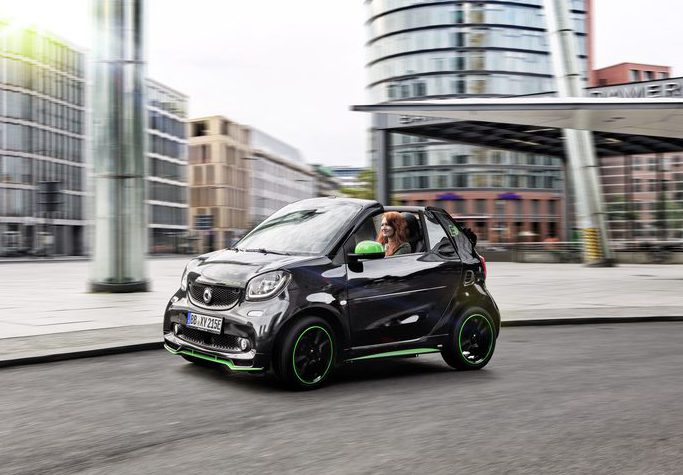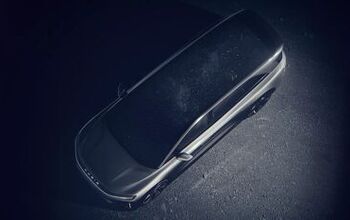Smart Stays the Course in Europe as It Shifts Focus in the United States

You’d probably never guess this from examining any parking lot in suburban North America, but Daimler’s microcar brand is actually doing exceedingly well. Despite the global trend toward crossovers, Smart saw record sales last year and increased its global volume 21 percent to 144,479 units. More amazing is that it’s still a brand that owes the entirety of its success to one niche market.
Smart doesn’t seem interested in changing course, either. While it’s abandoning internal combustion units to pursue a strict EV-only mentality in the United States, it will be business as usual for the the rest of the planet. But, with much of the industry offering spanking new compact crossovers and with fuel prices still so low, wouldn’t it be in Smart’s best interest to look beyond the limited microcar segment?
Not according to Annette Winkler, head of Smart since 2010. In a recent interview with Automotive News, she said there was no need to branch out. “In this current generation of models, I don’t see the necessity for a crossover,” she said. “We should also stick to what Smart always wanted to be and was invented to be: the perfect city car with smart solutions that provide more quality of life in an urban environment.”
Instead Smart will pursue ways to integrate the ForTwo and overseas-only ForFour with smartphones. In fact, Daimler will likely continue using the brand as a testing ground for experimental services. Car2Go is a good example. Initially, the ride-sharing application was exclusive to Smart-branded vehicles — which I’ve seen encroaching on ZipCar’s territory all over New York City. Now, after a successful test run, Mercedes-Benz has begun inserting its own vehicles into that fleet.
Market research has also shown that urbanites, who are much more likely to own a Smart, are more interested in connectivity services and willing to pay for high-tech features — making them the perfect guinea pigs.
It is, however, a limiting segment in some markets. Smart sales dwindled in the United States, never again reaching the success of its rookie year — 24,622 units in 2008. Meanwhile, Canada has seen middling sales since the brand’s launch. This eventually resulted in Daimler’s decision to take combustion engined units out of the U.S. and focus entirely on electrics. A good case could also be made for the bad publicity surrounding the ForTwo’s tendency for engine fires having something to do with it.
“With the previous generation, in peak times electric variants were responsible for a quarter of our U.S. sales and more than 50 percent in Canada. We think that this openness to the electric drive from our customers is very important and my view is that the Smart EV is the smartest Smart ever,” Winkler explained. “Secondly, there is a business impact for us. The microcar segment in the U.S. is shrinking more and more, so it makes sense to focus on the variant that has the bigger potential. In the U.S., this is certainly the electric drive.”
While Winker says this isn’t a strategy the company plans to pursue in other markets, she asserts it’s all part of some original scheme to grow EVs in North America, citing the country’s superior electric infrastructure and describing the ForTwo Cabriolet as the perfect vehicle for eco-friendly states.
“There are no other battery-only open cars so it is a perfect proposition for states such as California and Florida,” she said. “Also, don’t forget that Smart was invented from the very beginning to become electric.”
Smart is likely to see continued success in other countries but, outside of major metropolitan areas, its appeal remains limited in the United States. That could always change if there were a sudden gas shortage, but as an EV-specific brand with only a two-seater on offer, it wouldn’t be inconceivable to see it relegated to ride-sharing services. With 2.2 million Car2Go users at the end of 2016 making 74 million trips, that might not big a terrible space to occupy.
[Images: Mercedes-Benz]

A staunch consumer advocate tracking industry trends and regulation. Before joining TTAC, Matt spent a decade working for marketing and research firms based in NYC. Clients included several of the world’s largest automakers, global tire brands, and aftermarket part suppliers. Dissatisfied with the corporate world and resentful of having to wear suits everyday, he pivoted to writing about cars. Since then, that man has become an ardent supporter of the right-to-repair movement, been interviewed on the auto industry by national radio broadcasts, driven more rental cars than anyone ever should, participated in amateur rallying events, and received the requisite minimum training as sanctioned by the SCCA. Handy with a wrench, Matt grew up surrounded by Detroit auto workers and managed to get a pizza delivery job before he was legally eligible. He later found himself driving box trucks through Manhattan, guaranteeing future sympathy for actual truckers. He continues to conduct research pertaining to the automotive sector as an independent contractor and has since moved back to his native Michigan, closer to where the cars are born. A contrarian, Matt claims to prefer understeer — stating that front and all-wheel drive vehicles cater best to his driving style.
More by Matt Posky
Latest Car Reviews
Read moreLatest Product Reviews
Read moreRecent Comments
- Honda1 Unions were needed back in the early days, not needed know. There are plenty of rules and regulations and government agencies that keep companies in line. It's just a money grad and nothing more. Fain is a punk!
- 1995 SC If the necessary number of employees vote to unionize then yes, they should be unionized. That's how it works.
- Sobhuza Trooper That Dave Thomas fella sounds like the kind of twit who is oh-so-quick to tell us how easy and fun the bus is for any and all of your personal transportation needs. The time to get to and from the bus stop is never a concern. The time waiting for the bus is never a concern. The time waiting for a connection (if there is one) is never a concern. The weather is never a concern. Whatever you might be carrying or intend to purchase is never a concern. Nope, Boo Cars! Yeah Buses! Buses rule!Needless to say, these twits don't actual take the damn bus.
- MaintenanceCosts Nobody here seems to acknowledge that there are multiple use cases for cars.Some people spend all their time driving all over the country and need every mile and minute of time savings. ICE cars are better for them right now.Some people only drive locally and fly when they travel. For them, there's probably a range number that works, and they don't really need more. For the uses for which we use our EV, that would be around 150 miles. The other thing about a low range requirement is it can make 120V charging viable. If you don't drive more than an average of about 40 miles/day, you can probably get enough electrons through a wall outlet. We spent over two years charging our Bolt only through 120V, while our house was getting rebuilt, and never had an issue.Those are extremes. There are all sorts of use cases in between, which probably represent the majority of drivers. For some users, what's needed is more range. But I think for most users, what's needed is better charging. Retrofit apartment garages like Tim's with 240V outlets at every spot. Install more L3 chargers in supermarket parking lots and alongside gas stations. Make chargers that work like Tesla Superchargers as ubiquitous as gas stations, and EV charging will not be an issue for most users.
- MaintenanceCosts I don't have an opinion on whether any one plant unionizing is the right answer, but the employees sure need to have the right to organize. Unions or the credible threat of unionization are the only thing, history has proven, that can keep employers honest. Without it, we've seen over and over, the employers have complete power over the workers and feel free to exploit the workers however they see fit. (And don't tell me "oh, the workers can just leave" - in an oligopolistic industry, working conditions quickly converge, and there's not another employer right around the corner.)
































Comments
Join the conversation
I was very excited when they decided to roll out a manual variant here in the US...until I saw the price tag for a new one. Yikes! Used first gen smarts are pretty cheap and I would "almost" consider one for a DD as my commute is a short 15 minutes and I am always the only pax in my car.
Unless you have severe parking problems, a Prius is a better solution.